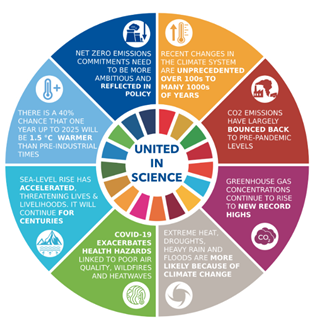‘United in Science 2021’ Report
- 17 Sep 2021
A new climate change report (United in Science 2021) was released on 16th September 2021 shows that limiting global warming to 1.5 degrees Celsius will be impossible without immediate, large-scale emissions cuts.
- The report, published by a range of UN agencies and scientific partners just weeks before the COP26 climate summit, said that climate change and its impacts were accelerating. And a temporary reduction in carbon emissions caused by the COVID-19 pandemic had done nothing to slow the relentless warming, the report found.

Key Findings of the Report
Greenhouse Gas Concentrations in the Atmosphere (Global Atmosphere Watch/WMO)
- Concentrations of the major greenhouse gases – CO₂, CH₄ and N₂O – continued to increase in 2020 and the first half of 2021.
- Overall emissions reductions in 2020 likely reduced the annual increase of the atmospheric concentrations of long-lived greenhouse gases, but this effect was too small to be distinguished from natural variability.
- Reducing atmospheric methane (CH₄) in the short term could support the achievement of the Paris Agreement. This does not reduce the need for strong, rapid and sustained reductions in CO₂ and other greenhouse gases.
Global Carbon Budget – GCP (Global Carbon Project)
- Fossil CO₂ emissions – coal, oil, gas and cement – peaked at 36.64 GtCO₂ in 2019, followed by an extraordinary drop of 1.98 GtCO₂ (5.6%) in 2020 due to the COVID-19 pandemic.
- The drop in CO₂ emissions is temporary, and based on preliminary estimates, from January–May 2021 global emissions in the power, industry and residential sectors were already at the same level or higher than in the same period in 2019. Emissions from road transport remained about 6% lower.
- Recent emissions trends of N₂O, the third most important greenhouse gas after CO₂ and CH₄, exceed the most greenhouse gases intense socioeconomic pathways used to explore future climate change.
Global Climate in 2017–2021 (WMO)
- The global average mean surface temperature for the period from 2017–2021 is among the warmest on record, estimated at 1.06 °C to 1.27 °C above pre-industrial (1850–1900) levels.
- In every year from 2017 to 2021, the Arctic average summer minimum and average winter maximum sea-ice extent were below the 1981–2010 long term average. In September 2020, the Arctic sea-ice extent reached its second lowest minimum on record.
- 2021 recorded devastating extreme weather and climate events – a signature of man-made climate change has been identified in the extraordinary North American extreme heat and west European floods.
Highlights of IPCC Climate Change 2021 - The Physical Science Basis for the Current State of Climate (IPCC)
- It is unequivocal that human influence has warmed the atmosphere, ocean and land. Widespread and rapid changes in the atmosphere, ocean, cryosphere and biosphere have occurred.
- The scale of recent changes across the climate system as a whole and the present state of many aspects of the climate system are unprecedented over many centuries to many thousands of years.
- Human-induced climate change is already increasing the frequency and intensity of many weather and climate extremes in every region across the globe.
Heatwaves, Wildfires, and Air Pollution: Compounding and Cascading Climate Hazards to Health (WHO/WMO)
- Rising temperatures are linked to increased heat-related mortality and work impairment, with an excess of 103 billion potential work hours lost globally in 2019 compared with those lost in 2000.
- COVID-19 recovery efforts should be aligned with national climate change and air quality strategies to reduce risks from compounding and cascading climate hazards, and gain health co-benefits.
Sea- level and Coastal Impacts WCRP (WMO/IOC/ISC)
- Global mean sea levels rose 20 cm from 1900 to 2018 and at an accelerated rate of 3.7+0.5 mm/yr from 2006 to 2018.
- Even if emissions are reduced to limit warming to well below 2 °C, global mean sea level would likely rise by 0.3–0.6 m by 2100, and could rise 0.3–3.1 m by 2300.
- Adaptation to this residual rise will be essential – adaptation strategies are needed where they do not exist – especially in low-lying coasts, small islands, deltas and coastal cities.
Global Climate in 2021–2025 – WMO Global Annual to Decadal Climate Update (Met Office/WMO/WCRP)
- Annual global mean near-surface temperature is likely to be at least 1 °C warmer than pre-industrial levels (defined as the 1850–1900 average) in each of the coming five years and is very likely to be within the range 0.9 °C to 1.8 °C.
- Over 2021–2025, high latitude regions and the Sahel are likely to be wetter than the recent past.
- There is a 40% chance that average global temperature in one of the next five years will be at least 1.5 °C warmer than pre-industrial levels but it is very unlikely (~10%) that the 5-year mean temperature for 2021–2025 will be 1.5 °C warmer than pre-industrial levels.
Emissions Gap (United Nations Environment Programme – UNEP)
- Five years after the adoption of the Paris Agreement, the emissions gap is as large as ever: global emissions need to be 15 GtCO₂e lower than current unconditional Nationally Determined Contributions (NDCs) imply for a 2 °C goal, and 32 GtCO₂e lower for the 1.5 °C goal.
- The COVID-19 crisis offers only a short-term reduction in global emissions. It will not significantly reduce emissions by 2030 unless countries pursue an economic recovery that incorporates strong decarbonization.
- The increasing number of countries committing to net-zero emission goals is encouraging, with about 63% of global emissions now covered by such goals. However, to remain feasible and credible, these goals urgently need to be reflected in near-term policy and in significantly more ambitious NDCs for the period to 2030.




